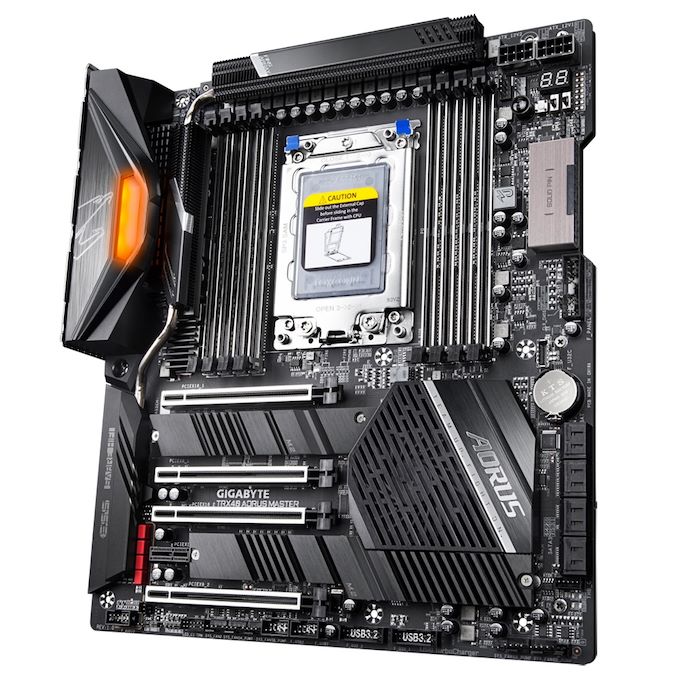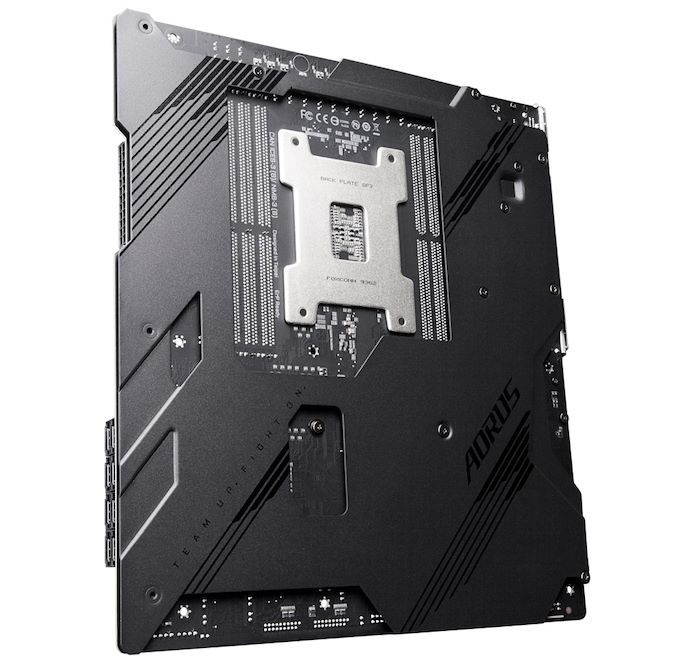The AMD TRX40 Motherboard Overview: 12 New Motherboards Analyzed
by Gavin Bonshor on November 28, 2019 9:00 AM EST- Posted in
- Motherboards
- AMD
- MSI
- Gigabyte
- ASRock
- Asus
- TRX40
- Threadripper 3000
- Castle Peak
GIGABYTE TRX40 Aorus Master
The GIGABYTE TRX40 Aorus Master sits below the TRX40 Aorus Xtreme in the product stack and combines a similar style, in a slightly smaller, but still larger than normal E-ATX PCB. Still retaining the high-end feel, the TRX40 Master is using an E-ATX PCB which is crammed with good quality controllers. The most notable features include support for DDR4-4400 and 256 GB, a pair of Ethernet ports on the rear panel including an Aquantia 5 G controller, Intel's AX200 Wi-Fi 6 wireless interface, and a beefy 16-phase CPU power delivery.
Starting from the top, the GIGABYTE TRX40 Aorus Master has eight memory slots in two banks of four on either side of the sTRX4 socket with support for DDR4-4400 and up to 256 GB in total. Taking a slightly more basic approach to the aesthetics, the rear panel cover does include integrated RGB LEDs, with black heatsinks on a black PCB. The large black aluminium power delivery heatsinks which are interconnected via a heat pipe are cooling a 16-phase power which consists of an Infineon XDPE132G5C 16-phase PWM controller, with sixteen Infineon TDA21472 70 A power stages. Providing power to the CPU is two 8-pin 12 V ATX power connectors which are located in the top right-hand corner.
Also at the top right-hand corner of the board is a two-digit LED debug, while below this is a right-angled 24-pin motherboard power connector. For PCIe devices, there are four full-length PCIe 4.0 slots which operate at x16/x8/x16+x8 and a single PCIe 4.0 x1 slot. The TRX40 chipset heatsink is actively cooled just as we saw with X570. For storage, the GIGABYTE TRX40 Aorus Master has three PCIe 4.0 x4 M.2 slots which include M.2 heatsinks for each slot, and there are eight SATA ports with support for RAID 0, 1, and 10 arrays.
Like with the GIGABYTE TRX40 Aorus Xtreme, the TRX40 Aorus Master also includes a large black metal backplate which will add extra weight to the board. The backplate displays the motto 'Team Up, Fight On' which is more of a gaming term, which is understandable given the boards Aorus branding. The TRX40 Aorus Master includes dual BIOS with a switch which allows users to select between the two, and for cooling, there is a total of eight 4-pin headers. These are split into one for a CPU fan, one dedicated for a water pump, and six for chassis fans.
On the rear panel are five USB 3.1 G2 Type-A, one USB 3.1 G2 Type-C, and two USB 2.0 ports. There are two Ethernet ports with one controlled by an Aquantia 5 G, and the other by an Intel Gigabit Ethernet controller. This model also includes Intel's AX200 Wi-Fi 6 wireless interface and also adds BT 5.0 connectivity too. To the left-hand side is a Clear CMOS and Q-Flash Plus switch, with the five 3.5 mm audio jacks and S/PDIF optical output handled by a Realtek ALC4050H and Realtek ALC1220 audio codec pairing. The TRX40 Aorus Master also includes a Realtek ALC4050H and ESS Sabre 9218 DAC for the front panel audio.
The GIGABYTE TRX40 Aorus Master is still a high-end TRX40 motherboard and with an MSRP of $499, it isn't exactly cheap, but it does offer users plenty of good quality features on AMD's new HEDT platform. While the Aorus brand is mainly targeted at gamers, the TRX40 Aorus Master looks to combine elements from both the enthusiast and gaming sides, to create a reasonably priced multi-purpose model for all looking to use and unlock all of the power within the Threadripper 3000 processors.













109 Comments
View All Comments
Bccc1 - Friday, November 29, 2019 - link
My case fans are Noctua NF-S12A running at max 500rpm. CPU and GPU are watercooled with an external pump and radiator sitting a few meters away with acoustic isolation. So I'm pretty sure I would hear the chipset fans.I was expecting to shell out ~$1000 for a completly passive Gigabyte board, or even more if it had a PEX chip to use even more PCIe cards, and am very dissapointed that that doesn't exist. Any suggestions for a DIY mod?
eek2121 - Friday, November 29, 2019 - link
You are nuts if you think a tiny little low RPM chipset fan is bad. Chipset fans are inevitable (though a die shrink may temporarily make this go away until PCIE5), and the fact is, the fan on your PSU, GPU, or case fans, even at low levels, will drown out any noise from a chipset fan. Even if the PSU fan is off and you have water cooling, the case fans, at even 400 rpm, make more noise than the chipset fan. Note that it's not currently possible to have every fan in a system shut off on high end platforms, except the chipset fan itself might shut off. Even with an AIO, there must be some airflow for the radiator.Sivar - Monday, December 2, 2019 - link
It's really more a matter of long-term reliability based on my past experience.If a 120mm CPU fan starts to die, get loud, burns out due to dust, or otherwise becomes damaged, it isn't an issue to replace it even 5 years from now. With a proprietary motherboard CPU/heatsink, we are at the mercy of the vendor's long-term support.
realbabilu - Friday, November 29, 2019 - link
Any motherboard s TRX with ipmi? I mean it would be a workstation or a server, a nice ipmi remote will be nice.msroadkill612 - Friday, November 29, 2019 - link
"the TRX40 chipset, and offers 24 PCIe 4.0 lanes to the system. That being said, eight of those are used for the CPU-to-chipset connection, leaving 16 for ports and other devices. This is on top of the 64 PCIe 4.0 lanes for the CPU: 64 + 24 = 88 PCIe 4.0 lanes total, but the x8 link in each direction between CPU and chipset gives a usable 72 PCIe 4.0 lanes for the platform."WHAT???
howsabout?:
The chipset uses 8 of the 64 lanes to create (multiplex?) 24x lanes - 8 of which are used for chipset usb & sata ports, leaving 16 lanes for various configurations of additional IO, at the discretion of the mobo maker.
sailorchou - Friday, November 29, 2019 - link
As I know, some boards have the type-c USB Gen3.2 x2 (20Gbps aggregation). Totally ignored?HJay - Friday, November 29, 2019 - link
The last thing an audio creator wants is some McGyvered / red-necked USB bridge hack-job of a motherboard. In this regard, the S1220 codec models are the only ones having my attention -the ASUS TRX40-Pro in particular since any Real content creator is going to stick their nose up at Wi-Fi. Does it have a secondary codec though? Thank you very much for the timely post which will, hopefully, prompt much discussion regarding the audio peculiarities.HJay - Friday, November 29, 2019 - link
I suppose audio creators will want to pay close attention to which socket is better suited to their work: AM4 or TR.Bccc1 - Friday, November 29, 2019 - link
Can you explain further? Why would an audio creator pay attention to the onboard audio if he will use his own audio interface? Even if it's only a cheap Focusrite Scarlett, why does the S1220 matter?Llawehtdliub - Saturday, November 30, 2019 - link
Because he's young and ignorant but highly opinionated.